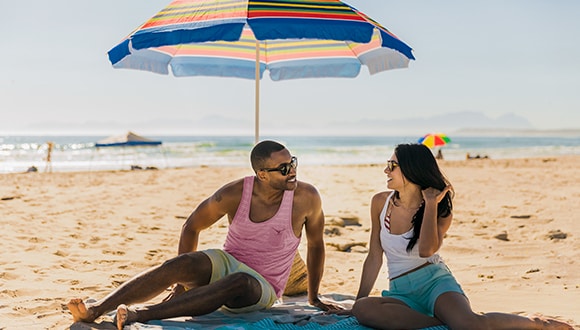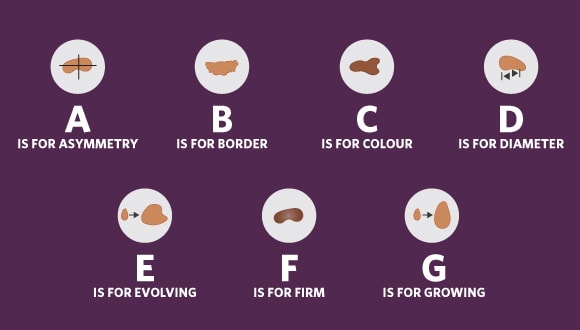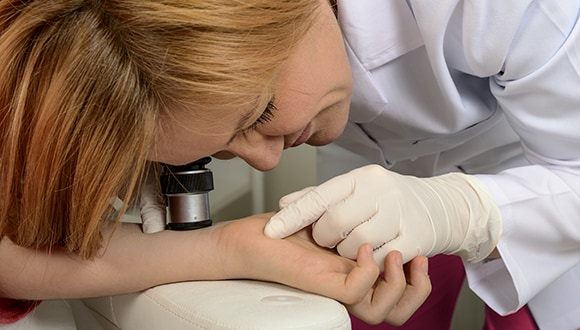What does skin cancer look like? How to spot the signs
Updated March 2024 | 6 min read
Expert contributor Professor Anne Cust, cancer epidemiologist and chair of Cancer Council’s Skin Cancer Committee
Words by Donnay Torr
Australia’s skin cancer rates are some of the highest in the world – but regular skin checks and sun safety can help with early detection and prevention.
Our country might be famous for its sunshine, beautiful beaches and outdoor lifestyle, but the downside to this is that Australia has one of the highest rates of skin cancer in the world – two to three times the rate of Canada, the US and the UK.
Melanoma is the most dangerous type of skin cancer and the third most common cancer diagnosed in Australians, according to Cancer Council.
The main culprit? Our intense UV levels, which stay above 10 (very high) in most parts of Australia through summer, and often in spring and autumn, too.
"Most people don’t realise how intense the UV is in Australia and can get confused about the difference between heat and UV levels, and the risk of exposure at certain times of day or during different seasons," says Professor Anne Cust, chair of Cancer Council’s Skin Cancer Committee.
"UV rates are usually much lower at 8am or 5pm than at midday, for example – even when the temperature feels the same." You can track UV levels with Cancer Council’s free SunSmart Global UV app.

What does 'sun safety' mean?
Skin cancer might be one of the most common types of cancer, but it’s also one of the most preventable – if you’re consistent about sun safety.
It's important to note that Australia's sun safety guidelines were recently updated for the first time to include tailored advice for diverse skin types. These new guidelines acknowledge that the risks and benefits of sun exposure varies between individuals according to skin type and the underlying risk of skin cancer. The recommendations are targeted to three groups: high risk, intermediate risk and low risk.
Cancer Council’s SunSmart program suggests you:
- slip on sun-protective clothing, like rashies or long-sleeved shirts
- slop on broad spectrum sunscreen (minimum SPF30) at least every two hours
- slap on a broad-brimmed hat
- seek shade
- slide on some sunglasses.
While the advice on how to stay sun safe may be familiar to most Australians, many of us don't do enough, says Prof Cust. "Mostly because people get busy, forget or rely on just one thing instead of taking multiple precautions to prevent melanoma," she says. "You shouldn’t just be putting on sunscreen, but also trying to stay in the shade and wearing a hat and protective clothing." And, of course, going for regular skin checks if you are at high risk or if you notice a new or changing spot on your skin.
Anybody can get skin cancer but there are certain factors that can increase your risk, according to Cancer Council. These include:
- Age: skin cancer becomes more common as you get older.
- Genetics: people with pale or freckled skin, red or fair hair and light-coloured eyes (blue or green) are more at risk than people with darker skin tones.
- Sun exposure: unprotected exposure to UV radiation, particularly in short, intense periods like on weekends or holidays increases your risk, as does working or spending lots of time outdoors.
- Behaviour: people who have actively tanned, sunbathed or used solariums have an increased risk of developing skin cancer.
- Moles/sunspots: if you have lots of moles, or lots of moles with an irregular shape and uneven colour, this can be a risk factor. Likewise for certain skin conditions that show damage from sun exposure, like sunspots.
Other risk factors include having a family history of melanoma, a weakened immune system from certain diseases or medical treatments, exposure to arsenic and smoking.
People with brown, black or olive skin have more protection against UV radiation because their skin produces more melatonin. However, they can still develop skin cancer.
Jessica Goode was just 27 when she was diagnosed with a Stage IB (early stage) melanoma after a colleague noticed a mole on her back and suggested she get it checked. The unexpected diagnosis made her feel "scared and a bit puzzled", as she hadn’t been sunburned in over a decade.
"Growing up and into my 20s, I'd associated skin checks and melanoma with older people or those who hadn't used enough sunscreen," says Jessica. "I was generally across sun protection, learning my lesson after a few nasty sunburns during my teenage years. I liberally applied sunscreen whenever I went to the beach, wore a hat if I remembered one and tried to stay in the shade. But I didn't always remember, or stayed out too long, or forgot to apply more sunscreen, and therein lies the rub – the sun is constant, while our protection against it isn't."
What does melanoma look like?
There are many different types of skin tumours, both cancerous and non-cancerous, but the most dangerous is melanoma.
It's important to regularly check your skin for any new spots or changes to existing moles or freckles.
"Anything that’s new or seems to be changing should be checked out, particularly if it looks a bit different to other things around it," advises Prof Cust.
She explains that health professionals are taught a set of criteria to help them identify a potentially cancerous mole, checking for any of these markers:
- A: Asymmetry
- B: Border irregularity
- C: Colour variability or change
- D: Diameter (larger) or Different
- E: Evolving
- F: Firm
- G: Growing

While having moles is a risk factor for getting melanoma, Prof Cust says you shouldn't remove harmless moles to prevent skin cancer. "Some people have hundreds of moles, and it would just be unrealistic and harmful to remove them," she says. "Most moles are fine, and most melanomas are detected early, which makes the prognosis really good."
Along with keeping an eye on all your moles and going for annual skin checks, it can be helpful to have photographs taken of them as a record to check against later for any changes. "But we don’t take anything out that’s just there and not changing," says Prof Cust.

Skin tag versus mole: which ones can be cancerous?
Skin tags tend to form on the skin’s surface in places where the skin rubs together. Skin tags hang off the skin, while moles tend to be rooted. Another way to tell the difference is that hairs can grow inside moles but not on skin tags.
Some moles are precancerous and can turn into melanoma, while skin tags are benign (non-cancerous) growths.
Genetics can play a big part in the number of moles people have; however, moles are also more common in people who have had lots of sun exposure – particularly in childhood. Skin tags are common with ageing and are largely unavoidable (although they are more common in people who are overweight or obese). Doctors can advise on how to manage health conditions that raise your risk of skin tags by eating well, exercising, getting enough sleep and losing weight if needed.
Do skin checks hurt?
Short answer? No. "Getting a skin check doesn’t necessarily mean you’ll have anything chopped out – the majority of people will just walk in, have their skin looked over and walk out," says Prof Cust.
But if your doctor does find something concerning, they may remove it or take a sample of it straight away for testing, especially if it has been changing. If they are uncertain, it may be monitored instead, in which case the doctor will take a photo and re-check in about three months to see if anything has changed.
"Regular skin checks are important for people at high risk because they help to detect melanoma early, which makes it much easier to treat," says Prof Cust. "The surgery to remove it will be much simpler, and it will heal quicker. Later-stage melanomas may need additional therapies to treat them, not just surgery."
How is melanoma treated?
When caught early, 90% of melanomas can be cured with surgical removal alone. If a melanoma is thick, your doctor will recommend further investigations to check if it has spread to lymph nodes or other organs. If it has spread, other treatments will be recommended. In Jessica's case, she had a wide excision surgery performed the day after her results came back, along with a sentinel lymph node biopsy to be safe. "I now have an almost 13cm scar where a mole used to be."
If you're diagnosed with melanoma, your team of medical professionals will develop a melanoma treatment plan, but Jessica suggests asking questions to get all the information you need, including what stage your melanoma is, what that means, what your treatment options are, how long it takes to recover, how you should take care of any surgery sites and anything else you need to know.
"My doctor didn't tell me what IB meant [stage IB melanoma: The melanoma tumour is more than 1mm and less than 2mm thick without ulceration] while delivering the diagnosis, and, without that clarification, my imagination ran a bit wild before research reined it in," she says. "Skip the anxiety. Ask if they can prepare a doctor's certificate for work reasons if you're going in for a wide excision – even if it's on a leg or arm or an area that won't impact your day to day, there’s still the mental side. Give yourself time."
Australia has some of the harshest levels of UV radiation in the world, and it pays to be careful – as Jessica has learned. "It doesn’t matter how perfectly you apply the slip, slop, slap, seek and slide rules, you can still be diagnosed with melanoma and/or other skin cancers," she says. "So, get your skin checked every year. You’re not too young, too old or too busy. It’s quick and may save your life."
Book your skin check
Services like MoleMap offer a way of monitoring moles over time to look for changes. MoleMap provides a thorough head-to-toe skin assessment and any suspicious moles are imaged and sent for dermatologist diagnosis. Checks only take 20 minutes and can be booked online without a GP referral.
Related articles
Health checks by age
Your guide to staying on top of your health with the right screening checks for every life stage and age. When it comes to your health, prevention is better than cure.
Sun safety in Australia
Australia has some of the highest UV radiation levels in the world. We look at why this can increase your risk of skin cancer and how to protect yourself.
Boost your health outdoors
Spending more time in blue space, like water, and green space, like parks, can help you de-stress, get fitter and improve your memory. Take a look at the health benefits.
Skin tumour removal
Learn the different types of skin tumours, major risk factors, what to expect from a skin tumour removal procedure, what it may cost and what your recovery might involve.